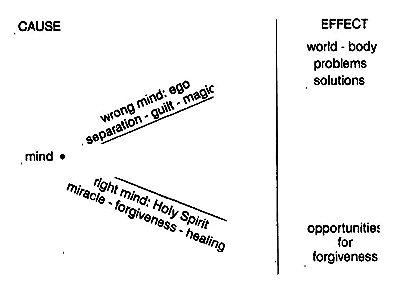 
The Fifty Miracle Principles of A Course in Miracles by Kenneth Wapnick
Introduction continued - Part 2
Let me mention one of the inconsistencies you will find, which is basically what we will be talking about today: what a miracle is, the subject of A Course in Miracles. One of the principles which we will be covering later speaks of a miracle as healing. In Chapter 2, Jesus says, "To speak of 'a miracle of healing' is to combine two orders of reality inappropriately" (text, p. 19; T-2.IV.1:3). Yet, near the end of the text there are a few references which talk about a "miracle of healing" (e.g., text, p. 529; T-27.II.5:2). This apparent inconsistency is explained by keeping in mind the circumstances of the writing. In some of the early miracle principles, "miracle" is used almost in the way we would popularly use it: to talk about an external act, where there is some external shift in the world or someone's behavior. As becomes very clear in some of the other principles, and certainly is the central theme of the Course, a miracle is a correction in perception, just as in the workbook passage Gloria read; it is a correction in how we perceive and how we think. But there are, certainly, principles that seem to imply a change in behavior. In Chapter 2, when Jesus specifically talks about what healing is and begins a series of sections on that (text, p. 19; T-2.IV) he making a distinction between the miracle which is the shift in thought, and then the effect which would be healing. Later on in the book when those earlier explanations and distinctions are no longer necessary, the Course is much more poetic and, therefore, could be called somewhat loose in its expression and would then use the phrase "a miracle of healing." There is another miracle principle (21) that talks about God's forgiveness, while in the workbook there is a very clear statement, in fact it is repeated, which says that "God does not forgive because He has never condemned" (workbook, pp. 73, 99; W-pI.46.1:1; W-pI.60.1:2). Forgiveness is a correction for a hostile or angry thought. And since obviously God does not have those thoughts, there is no need for correction or forgiveness in Heaven. In the popular use of the word, however, we do speak of the forgiveness of God. In fact, one of the lovelier passages in the text, which is the Course's version of the Lord's Prayer, begins with the words, "Forgive us our illusions, Father" (text, p. 326; T-16.VII.12:1). So if you are looking for inconsistencies in the Course, you are going to find them. If you want to make trouble with Jesus, and use the various inconsistencies as a way of disproving or taking issue with his Course, then you do not have to go past page one or two. In fact, in the early months, Helen was trying very hard to do that, and he told her he wished she would not do that because it was wasting a lot of time. Overall, one of the most remarkable things about A Course in Miracles is its consistency from beginning to end in what it teaches and what it says. It never deviates from that; but its expressions are not always quite as consistent. Before we actually start going through the fifty principles line by line, I would like to put something on the board as a way of orienting us in our discussion of miracles. None of us was very happy with the title that Jesus gave to the Course, but he seemed clear that he wanted to call it A Course in Miracles. So, it is the miracle that is the primary concern, and that is what we are really being taught. The miracle, once again, has nothing to do with anything external, the major reason being that there is nothing external.
Today we are not going to go into the Course's metaphysics; we are going to assume that we accept that principle. But, certainly, the basic metaphysical foundation of the Course is that there is no world outside us. It is only a projection of what is inside us, which means that the central issue always can be found in the little dot over there on the left side of the chart, which represents the mind. The mind projects what is within it onto the world; and the world, of course, includes not only the world at large, the universe, but also the world of our personal bodies. This means that the problem is never what is outside us here in the world. The problem is always what is in our minds; and since that is where the problem is, that is where the answer must be found also. That answer is the miracle. The best definition of what a miracle is, then, is that it is a correction for a misthinking or a misperception, and therefore A Course in Miracles will never advocate that you do anything about changing your behavior. Many of you may have seen the article on the Course in the New York Times about a month ago (Dec. 9,1984) in which I was quoted backwards. The quote said that you should change your behavior, and that changes your mind. I am sure I said the exact opposite to them on the phone: that your change of mind will correspondingly shift your behavior. This does not mean, by the way, that the Course would not advocate many times doing something to shift your behavior. All that it would say is that you not believe that by changing your behavior you have changed the problem. It could be a useful step towards changing a problem, but the basic problem is never out in the world or the body -- it is in the mind. This idea, of course, is absolutely essential to everything that the Course teaches and everything that we will be talking about. Certainly it is essential for understanding what the miracle is. The simplest definition of a miracle is that it is a correction for how we perceive or for how we think.
|
